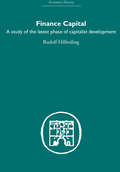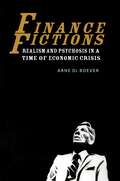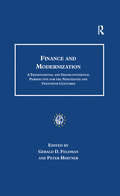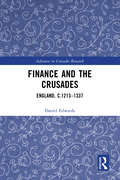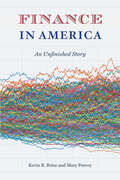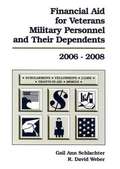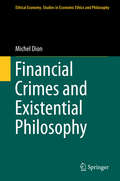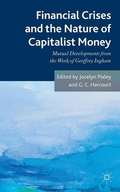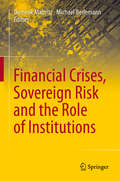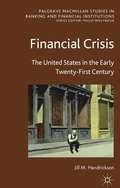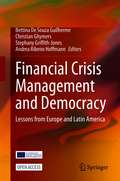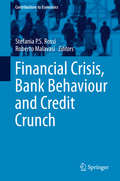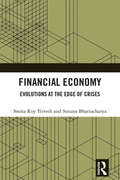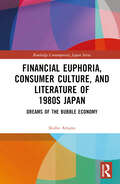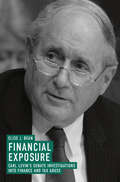- Table View
- List View
Finance Capital: A study in the latest phase of capitalist development
by Rudolph HiferdingThis is the first English translation of one of the classical works of Marxist economic theory. When Rudolf Hilferding’s Finance Capital was first published in 1919 it was acclaimed by reviewers as a continuation of Marx’s Capital, and it has a major influence upon subsequent Marxist thought, especially in the analysis of imperialism where it provided some of the fundamental ideas for the theories of Bukharin and Lenin. But Hilferding’s work was much more than a study of imperialism, which was presented only in the last section of the book. It set out to examine the main tendencies in the development of the capitalist mode of production as a whole at the beginning of the twentieth century, beginning with an exposition of the theory of money (in which particular attention was paid to the growth of credit money), then analysing the increasingly important role of the banks in the mobilization of capital, along with the development of large corporations, cartels and trusts, and finally outlining a theory of economic crises. Hilferding’s book has, however, more than an historical interest. It is a model for any renewed attempt to understand the ‘latest phase of capitalist development’ in the closing decades of the twentieth century, and Hilferdin’s ideas still provide essential elements for the elaboration of theoretically enlightened and realistic policies in the socialist movement.
Finance Fictions: Realism and Psychosis in a Time of Economic Crisis
by Arne De BoeverFinance Fictions takes the measure of what it means to live in a world ruled by high finance by examining the tension between psychosis and realism that plays out in the contemporary finance novel. When the things traded at the center of the economy cease to be things at all, but highly abstracted speculations, how do we come to see the real? What sorts of narrative can accurately approach the actual workings of a neoliberal economy marked by accelerating cycles of market crashes, economic and political crisis, and austerity?Revisiting such twentieth-century classics of the genre as Tom Wolfe's Bonfire of the Vanities and Bret Easton Ellis’s American Psycho, De Boever argues that the twenty-first century is witnessing the birth of a new kind of realistic novel that can make sense of complex financial instruments like collateralized debt obligations, credit default swaps, and digital algorithms operating at speeds faster than what human beings or computers can record. If in 1989 Wolfe could still urge novelists to work harder to “tame the billion-footed beast of reality,” today’s economic reality confronts us with a difference that is qualitative rather than quantitative: a new financial ontology requiring new modes of thinking and writing.Mobilizing the philosophical thought of Quentin Meillassoux in the close reading of finance novels by Robert Harris, Michel Houellebecq, Ben Lerner and less well-known works of conceptual writing such as Mathew Timmons’ Credit, Finance Fictions argues that realism is in for a speculative update if it wants to take on the contemporary economy—an “if” whose implications turn out to be deeply political. Part literary study and part philosophical inquiry, Finance Fictions seeks to contribute to a new mindset for creative and critical work on finance in the twenty-first century.
Finance and Democracy: Towards a Sustainable Financial System
by Alessandro VercelliThis book is an extension of the author's last book (Crisis and Sustainability: The Delusion of Free Markets, Palgrave Macmillan, 2017) and sheds light on the evolution of the financial system after the 2007/08 crisis and on changes and developments in the regulatory framework that have taken place concurrently over the last ten years. The book’s central theme addresses the neoliberal philosophy of financial regulation and, in particular, the role of self-regulating markets in the finance sector and how this has affected incentives and behaviour within the finance sector. The author contends that neoliberal maxims have led us to believe that market-based finance is superior to, and safer than, a more rules-based regulatory regime for the sector, and then explains that experience suggests otherwise. The huge expansion of ‘financialization’ in the developed economies over the last two decades has greatly magnified the risks emanating from the impact of highly leveraged, risk averse, under-regulated finance on other sectors of these economies. The author concludes that financial institutions need to be encouraged to operate within a more socially responsible matrix that facilitates and promotes long-term economic growth coupled with social stability.
Finance and Modernization: A Transnational and Transcontinental Perspective for the Nineteenth and Twentieth Centuries (Studies in Banking and Financial History)
by Gerald D. FeldmanFinance and Modernization centres on a set of historical developments and problems typified by the long history of the Österreichische Creditanstalt and its successor organizations, and opens the way to compare and contrast experiences throughout Central and Western Europe and also on other continents. The structure of this volume reflects the changing role and nature of banks as economies become industrialized and modernized. Although banks adapt to the needs of an industrializing economy, at the same time, industrialization influences the manner in which banking systems grow and the structures which they adopt. Beginning with studies of the Austrian banks, their development and their crises, the volume then moves on to look at case studies of important aspects of financial activity - German stock markets, railroad investment, and information networks. This is followed by a section on country studies of banking modernization in Sweden, the Netherlands and Greece. Finally, the collection concludes with two chapters, one on banking in China and the other on banking in India, certainly both of intrinsic interest and of importance in an era of globalization. Professor Teichova, one of the great scholars in the field, concludes with reflections on the individual contributions and the general problems addressed in this book.
Finance and the Crusades: England, c.1213-1337 (Advances in Crusades Research)
by Daniel EdwardsThis book investigates the financial aspects of crusading in the thirteenth and early fourteenth centuries. Taking the kingdom of England as a case study, it explores a variety of themes, such as how much crusades cost, how they were financed, how funds were transferred to the East and how crusaders fared financially after their return. Its fundamental argument, in contrast with current historiography, is that it was the "private" fundraising of individuals – not the "public" fundraising of the Crown and the Church – that constituted the life-blood of the crusade movement in the period under consideration. Indeed, it is likely that the crusades were only able to remain central to the religious and political life of England, and indeed western Christendom, because participants, and those in their connection, continued to be willing to sacrifice their own financial wellbeing for the interests of the Holy Land.
Finance in America: An Unfinished Story
by Kevin R. Brine Mary PooveyThe economic crisis of 2008 led to an unprecedented focus on the world of high finance—and revealed it to be far more arcane and influential than most people could ever have imagined. Any hope of avoiding future crises, it’s clear, rest on understanding finance itself. To understand finance, however, we have to learn its history, and this book fills that need. Kevin R. Brine, an industry veteran, and Mary Poovey, an acclaimed historian, show that finance as we know it today emerged gradually in the late nineteenth century and only coalesced after World War II, becoming ever more complicated—and ever more central to the American economy. The authors explain the models, regulations, and institutions at the heart of modern finance and uncover the complex and sometimes surprising origins of its critical features, such as corporate accounting standards, the Federal Reserve System, risk management practices, and American Keynesian and New Classic monetary economics. This book sees finance through its highs and lows, from pre-Depression to post-Recession, exploring the myriad ways in which the practices of finance and the realities of the economy influenced one another through the years. A masterwork of collaboration, Finance in America lays bare the theories and practices that constitute finance, opening up the discussion of its role and risks to a broad range of scholars and citizens.
Financial Aid for Veterans, Military Personnel and Their Dependents 2006-2008
by R. David Weber Gail Ann SchlachterVeterans, military personnel, and their dependents make up more than one third of America's population. Each year, public and private agencies set aside billions of dollars in financial aid for these groups (including the spouses, children, grandchildren, and dependent parents, and siblings of veterans and military personnel). If you have ties to the military, Financial Aid for Veterans, Military Personnel, and Their Dependents is the right book for you.
Financial Assets, Debt and Liquidity Crises: A Keynesian Approach
by Peter Flaschel Matthieu Charpe Carl Chiarella Willi SemmlerThe macroeconomic development of most major industrial economies is characterised by boom-bust cycles. Normally such boom-bust cycles are driven by specific sectors of the economy. In the financial meltdown of the years 2007-2009 it was the credit sector and the real-estate sector that were the main driving forces. This book takes on the challenge of interpreting and modelling this meltdown. In doing so it revives the traditional Keynesian approach to the financial-real economy interaction and the business cycle, extending it in several important ways. In particular, it adopts the Keynesian view of a hierarchy of markets and introduces a detailed financial sector into the traditional Keynesian framework. The approach of the book goes beyond the currently dominant paradigm based on the representative agent, market clearing and rational economic agents. Instead it proposes an economy populated with heterogeneous, rationally bounded agents attempting to cope with disequilibria in various markets.
Financial Crimes and Existential Philosophy
by Michel DionThe aim of this book is to deepen our understanding of financial crimes as phenomena. It uses concepts of existential philosophies that are relevant to dissecting the phenomenon of financial crimes. With the help of these concepts, the book makes clear what the impact of financial crimes is on the way a human being defines himself or the way he focuses on a given notion of humankind. The book unveils how the growth of financial crimes has contributed to the increase of the anthropological gap, and how the phenomenon of financial crimes now distorts the way we understand humankind. Using the existential philosophies of Kierkegaard, Nietzsche, Jaspers, Buber, Heidegger, and Marcel, the book sheds light on how these philosophies can help to better perceive and describe financial crimes. Next it looks at prevention strategies from an organizational perspective, using concepts of Sartre, Gadamer and Tillich. The book provides readers with existential principles that will help them be more efficient when they have to design and implement prevention strategies against corporate crime.
Financial Crises and the Nature of Capitalist Money: Mutual Developments from the Work of Geoffrey Ingham
by Jocelyn Pixley G. C. HarcourtThis volume is a debate about a sociology and economics of money: a form of positive trespassing. It is unique in being written by scholars of both disciplines committed to this mutual venture and in starting from the original groundwork laid by Geoffrey Ingham. The contributors look critically at money's institutions and the meanings and history of money-creation and show the cross cutting purposes or incommensurable sides of money and its crises. These arise from severe tensions and social conflicts about the production of money and its many purposes. We demonstrate the centrality of money to capitalism and consider social disorders since the 2007 crisis, which marks the timeliness and need for dialogue. Both disciplines have far too much to offer to remain in the former, damaging standoff. While we are thankful to see a possible diminution of this split, remnants are maintained by mainstream economic and sociological theorists who, after all the crises of the past 30 years, and many before, still hold to an argument that money really does not 'matter'. We suggest, to many different and interested audiences, that since money is a promise, understanding this social relation must be a joint though plural task between economics and sociology at the very least.
Financial Crises and the Politics of Macroeconomic Adjustments
by Stefanie WalterWhen are policy makers willing to make costly adjustments to their macroeconomic policies to mitigate balance-of-payments problems? Which types of adjustment strategies do they choose? Under what circumstances do they delay reform, and when are such delays likely to result in financial crises? To answer these questions, this book examines how macroeconomic policy adjustments affect individual voters in financially open economies and argues that the anticipation of these distributional effects influences policy makers' decisions about the timing and the type of reform. Empirically, the book combines analyses of cross-national survey data of voters' and firms' policy evaluations with comparative case studies of national policy responses to the Asian Financial Crisis of 1997/8 and the recent Global Financial Crisis in Eastern Europe. The book shows that variation in policy makers' willingness to implement reform can be traced back to differences in the vulnerability profiles of their countries' electorates.
Financial Crises, Sovereign Risk and the Role of Institutions
by Dominik Maltritz Michael BerlemannThe recent world economic crisis showed very clearly that financial crises and sovereign defaults are severe threats to economic and social prosperity. In addition, it became apparent that currency crises and banking crises often occur together and are closely related to sovereign debt crises and defaults. The present book contains new research on various important issues related to financial crises and sovereign default risk by leading experts in the field. The book discusses new modelling approaches to financial crises, defaults and their interdependencies. It also sheds light on the consequences of different sorts of crises for the trust in the institutions which are concerned with managing them. Moreover, it provides discussions of several institutional features of the EMU and the world financial system and in particular the risks inherent in these institutions. The book also includes interesting suggestions for solving crises and improving financial stability.
Financial Crises: Causes, Consequences, and Policy Responses
by M. Ayhan Kose Stijn Claessens Luc Laeven Fabián ValenciaA report from the International Monetary Fund.
Financial Crisis
by Jill M. HendricksonThe 2007-2009 financial crisis caught many by surprise. When the dust began to settle, people began looking around and asking how this could have happened and why we did not see it coming. Criticism fell heavily on the economics profession because there was a feeling that the models and theories of economics had failed to properly warn and prepare us for a significant crisis. This book carefully analyses existing theories of financial crisis to determine if they are still appropriate for understanding modern financial crises. This is an important endeavour because financial crisis theory has largely been ignored for many years. Indeed, it has been almost twenty years since economists have seriously reconsidered financial crisis theory. This book fills that gap and offers insight into the current debate regarding the efficacy of economic models and theories relevant to understanding financial distress.
Financial Crisis Inquiry Report: Final Report of the National Commission on the Causes of the Financial and Economic Crisis in the Un
by Financial Crisis Inquiry CommissionOfficial Government Edition The definitive report on what caused America's economic meltdownOCo and who was responsibleThe financial and economic crisis has touched the lives of millions of Americans who have lost their jobs and their homes, but many have little understanding of how it happened. Now, in this very accessible report, readers can get the facts. Formed in May 2009, the Financial Crisis Inquiry Commission (FCIC) is a panel of 10 commissioners with experience in business, regulations, economics, and housing, chosen by Congress to explain what happened and why it happened. This panel has had subpoena power that enabled them to interview people and examine documents that no reporter had access to. The FCIC has reviewed millions of pages of documents, and interviewed more than 600 leaders, experts, and participants in the financial markets and government regulatory agencies, as well as individuals and businesses affected by the crisis. In the tradition of The 9/11 Commission Report, "The Financial Crisis Inquiry Report" will be a comprehensive book for the lay reader, complete with a glossary, charts, and easy-to-read diagrams, and a timeline that includes important events. It will be read by policy makers, corporate executives, regulators, government agencies, and the American people.
Financial Crisis Management and Democracy: Lessons from Europe and Latin America
by Stephany Griffith-Jones Andrea Ribeiro Hoffmann Bettina De Souza Guilherme Christian GhymersThis open access book discusses financial crisis management and policy in Europe and Latin America, with a special focus on equity and democracy. Based on a three-year research project by the Jean Monnet Network, this volume takes an interdisciplinary, comparative approach, analyzing both the role and impact of the EU and regional organizations in Latin America on crisis management as well as the consequences of crisis on the process of European integration and on Latin America’s regionalism.The book begins with a theoretical introduction, exploring the effects of the paradigm change on economic policies in Europe and in Latin America and analyzing key systemic aspects of the unsustainability of the present economic system explaining the global crises and their interconnections. The following chapters are divided into sections. The second section explores aspects of regional governance and how the economic and financial crises were managed on a macro level in Europe and Latin America. The third and fourth sections use case studies to drill down to the impact of the crises at the national and regional levels, including the emergence of political polarization and rise in populism in both areas. The last section presents proposals for reform, including the transition from finance capitalism to a sustainable real capitalism in both regions and at the inter-regional level of EU-LAC relations.Written by an international network of academics, practitioners and policy advisors, this volume will be of interest to researchers and students interested in macroeconomics, comparative regionalism, democracy, and financial crisis management as well as politicians, policy advisors, and members of national and regional organizations in the EU and Latin America.
Financial Crisis and Bank Management in Japan (1997 to #2016)
by Mitsuhiko NakanoThis book explores the challenges faced by the Japanese economy and the Japanese banking industry following the financial crisis that emerged around the turn of the last millennium. The author explores how the Japanese financial crisis of the late 1990s engendered huge restructuring efforts in the banking industry, which eventually led to even more sweeping changes of the economic system and long-term deflation in the 2000s. The discussion begins with an overview of the unconventional monetary policy launched by the Bank of Japan at this time, while banking administrative policies maintained their strict code of governance. The author describes how, just as recovery seemed possible, the twin disasters of the Lehman shock and the Great East Japan Earthquake buffeted the recovering economy, and pushed Japan again into deflation. The book also looks to the very recent past, with the sudden advent of Abenomics in 2013, with its three-pronged approach, which was intended to break the deflationary mindset. Finally, the author projects what the future of the banking industry in Japan might encompass, as looming demographic changes gradually threaten both the economy and the banking industry.
Financial Crisis and Bank Management in Japan: Building a Stable Banking System (Palgrave Macmillan Studies in Banking and Financial Institutions)
by Mitsuhiko NakanoThis book explores the challenges faced by the Japanese economy and the Japanese banking industry following the financial crisis that emerged around the turn of the last millennium. The author explores how the Japanese financial crisis of the late 1990s engendered huge restructuring efforts in the banking industry, which eventually led to even more sweeping changes of the economic system and long-term deflation in the 2000s. The discussion begins with an overview of the unconventional monetary policy launched by the Bank of Japan at this time, while banking administrative policies maintained their strict code of governance. The author describes how, just as recovery seemed possible, the twin disasters of the Lehman shock and the Great East Japan Earthquake buffeted the recovering economy, and pushed Japan again into deflation. The book also looks to the very recent past, with the sudden advent of Abenomics in 2013, with its three-pronged approach, which was intended to break the deflationary mindset. Finally, the author projects what the future of the banking industry in Japan might encompass, as looming demographic changes gradually threaten both the economy and the banking industry.
Financial Crisis and Institutional Change in East Asia
by Jikon LaiIn light of the Asian financial crisis of 1997, Lai examines whether East Asian economies converged onto the liberal market model by studying the evolution of the financial sectors of Korea, Malaysia and Thailand. This includes sectoral diversification, the nature of competition, and the regulatory and supervisory frameworks.
Financial Crisis, Bank Behaviour and Credit Crunch
by Stefania P.S. Rossi Roberto MalavasiThis book explores some relevant distortions and market failures in financial and banking markets caused by the recent financial crisis and offers important insights to policymakers as well. After having introduced the reader to the economic background behind the origin of the present financial turmoil, the book proposes a distinct angle to look at some macro and microeconomic aspects. The volume discusses whether and to what extent policies, implemented by governments and monetary authorities to countervail bank defaults and avoid a disastrous financial instability, have in some way determined opportunistic conducts (moral hazard), changes in banks' behaviour, distortive incentives and market failures. Furthermore, the book offers a viewpoint on the effects of the evolution of regulation for the banking sector. Finally, the book assesses how the increase in the cost of funding and the shrinking in credit supply (credit crunch) has modified the financial structure of small and medium firms. To illustrate this, some specific cases at Italian regional level are examined.
Financial Crisis, Corporate Governance, and Bank Capital
by Sanjai BhagatIn the aftermath of the 2007-8 crisis, senior policymakers and the media have blamed excessive risk-taking undertaken by bank executives, in response to their compensation incentives, for the crisis. The inevitable follow-up to this was to introduce stronger financial regulation, in the hope that better and more ethical behaviour can be induced. Despite the honourable intentions of regulation, such as the Dodd-Frank Act of 2010, it is clear that many big banks are still deemed too big to fail. This book argues that by restructuring executive incentive programmes to include only restricted stock and restricted stock options with very long vesting periods, and financing banks with considerably more equity, the potential of future financial crises can be minimized. It will be of great value to corporate executives, corporate board members, institutional investors and economic policymakers, as well as graduate and undergraduate students studying finance, economics and law.
Financial Cycles
by Dimitris N. ChorafasChorafas argues that to overcome the more narrow limits of the business cycle, we need to go beyond its traditional six to seven year focus and address the longer term.
Financial Economy: Evolutions at the Edge of Crises
by Smita Roy Trivedi Sutanu BhattacharyaThis book examines how contemporary financial economy evolved as the predominant economic system, and why unabated accumulation of financial capital takes place in such systems. It reviews the mechanics of accumulation of wealth by tracing the historical roots of financial capital. Traversing the evolutions of capitalist systems since the 1850s till recent times, Financial Economy provides a lucid and logical explanation of the phenomenon. It uses a new methodology based on economic circuit of stocks and flows following the early ideas of the French economists of the 18th century and the contemporary Circuit school. It provides an alternative framework for studying economic systems design, keeping aside the orthodox neoclassical analysis of equilibrium market exchange. Further, it highlights the global financial circuit, the state of the current digitalised economy with electronic money transfers, consumer’s decision-making and expected future earnings, and questions the relevance of some fundamental concepts of economics as well as economic policies. Using a notion of sequential economy, it also shows how present economic activities are treading upon the future. This book will interest students and researchers of advanced macroeconomics, political economy, heterodox economics, economic history, and evolutionary economics. The historical account of the evolutions of capital, interest, and corporate structures will also be of interest to general readers.
Financial Euphoria, Consumer Culture, and Literature of 1980s Japan: Dreams of the Bubble Economy (Routledge Contemporary Japan Series)
by Ikuho AmanoThis book is an interdisciplinary study of Japan during the socially euphoric years of the Bubble Economy in the 1980s. Shedding light on consumer experiences, this study explores the socio-cultural landscape of Japan, the nation that boasted the second largest economy in the late twentieth century. Drawing its analysis from various media sources, popular literary works, and public reports, the book articulates how the late 1980s calibrated consumer demands, lifestyles, and perceptions of wealth. Through an examination of the qualitative effects of ‘Bubble money’ on consumers, the book disentangles the anatomy of the festive ambience in the economic phase, closely reading fictional and non-fictional literary works that play the role of reportage, critique, and satire. Through observations of human behaviours in consumption, the book reveals psychosomatic experiences and self-consciousness. Featuring a wide range of sources from Japanese media and literary works which have yet to be translated for an English audience, this book will be a valuable resource for students and scholars of modern Japanese culture and literature who are interested in the socio-economic landscape of late-twentieth-century Japan.
Financial Exposure: Carl Levin's Senate Investigations Into Finance And Tax Abuse
by Elise J. BeanAt a time when Congressional investigations have taken on added importance and urgency in American politics, this book offers readers a rare, insider’s portrait of the world of US Congressional oversight. It examines specific oversight investigations into multiple financial and offshore tax scandals over fifteen years, from 1999 to 2014, when Senator Levin served in a leadership role on the US Senate Permanent Subcommittee on Investigations (PSI), the Senate’s premier investigative body. Despite mounting levels of partisanship, dysfunction, and cynicism swirling through Congress during those years, this book describes how Congressional oversight investigations can be a powerful tool for uncovering facts, building bipartisan consensus, and fostering change, offering detailed case histories as proof. Grounded in fact, and written as only an insider could tell it, this book will be of interest to financial and tax practitioners, policymakers, academics, students, and the general public.
